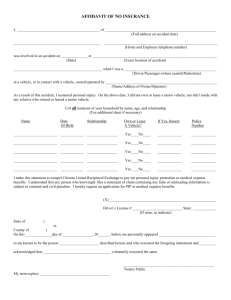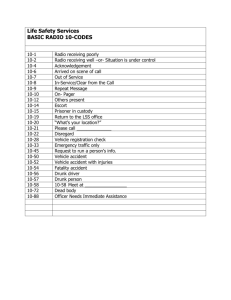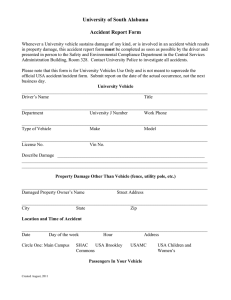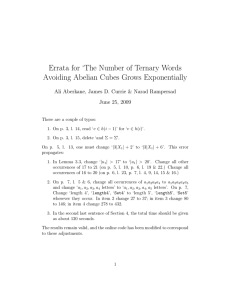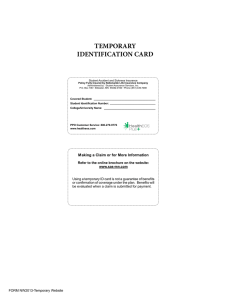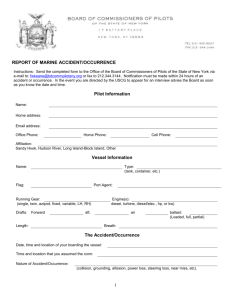INSURANCE CONSUMER COUNSEL’S COLUMN Introduction by Professor Greg Munro
advertisement
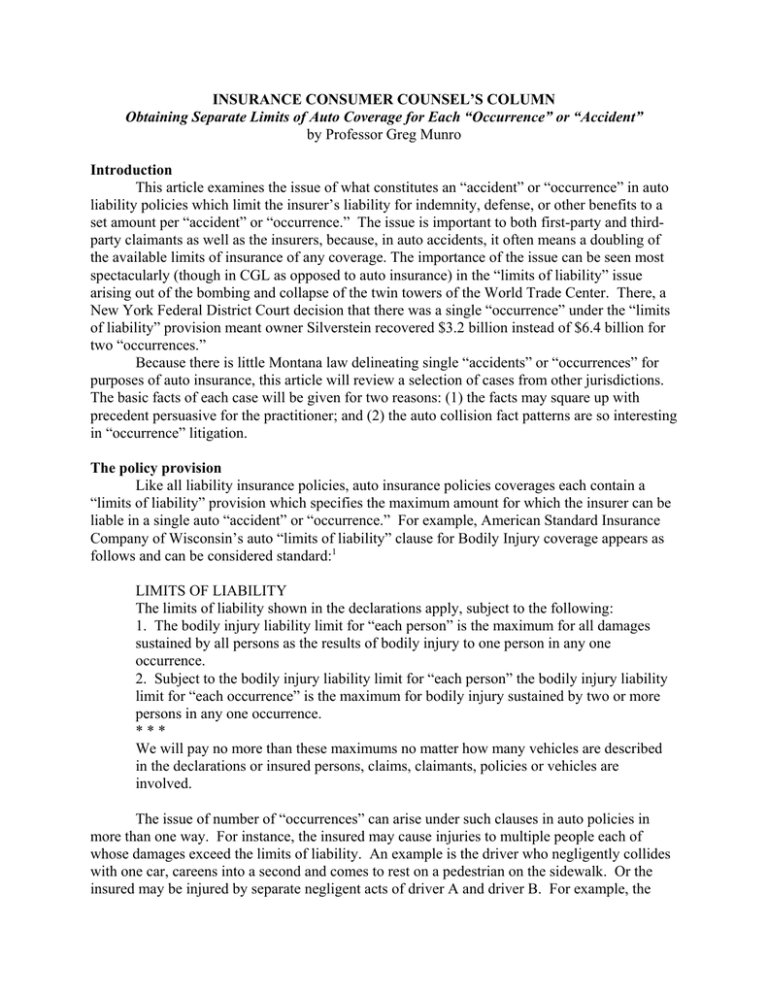
INSURANCE CONSUMER COUNSEL’S COLUMN Obtaining Separate Limits of Auto Coverage for Each “Occurrence” or “Accident” by Professor Greg Munro Introduction This article examines the issue of what constitutes an “accident” or “occurrence” in auto liability policies which limit the insurer’s liability for indemnity, defense, or other benefits to a set amount per “accident” or “occurrence.” The issue is important to both first-party and thirdparty claimants as well as the insurers, because, in auto accidents, it often means a doubling of the available limits of insurance of any coverage. The importance of the issue can be seen most spectacularly (though in CGL as opposed to auto insurance) in the “limits of liability” issue arising out of the bombing and collapse of the twin towers of the World Trade Center. There, a New York Federal District Court decision that there was a single “occurrence” under the “limits of liability” provision meant owner Silverstein recovered $3.2 billion instead of $6.4 billion for two “occurrences.” Because there is little Montana law delineating single “accidents” or “occurrences” for purposes of auto insurance, this article will review a selection of cases from other jurisdictions. The basic facts of each case will be given for two reasons: (1) the facts may square up with precedent persuasive for the practitioner; and (2) the auto collision fact patterns are so interesting in “occurrence” litigation. The policy provision Like all liability insurance policies, auto insurance policies coverages each contain a “limits of liability” provision which specifies the maximum amount for which the insurer can be liable in a single auto “accident” or “occurrence.” For example, American Standard Insurance Company of Wisconsin’s auto “limits of liability” clause for Bodily Injury coverage appears as follows and can be considered standard:1 LIMITS OF LIABILITY The limits of liability shown in the declarations apply, subject to the following: 1. The bodily injury liability limit for “each person” is the maximum for all damages sustained by all persons as the results of bodily injury to one person in any one occurrence. 2. Subject to the bodily injury liability limit for “each person” the bodily injury liability limit for “each occurrence” is the maximum for bodily injury sustained by two or more persons in any one occurrence. *** We will pay no more than these maximums no matter how many vehicles are described in the declarations or insured persons, claims, claimants, policies or vehicles are involved. The issue of number of “occurrences” can arise under such clauses in auto policies in more than one way. For instance, the insured may cause injuries to multiple people each of whose damages exceed the limits of liability. An example is the driver who negligently collides with one car, careens into a second and comes to rest on a pedestrian on the sidewalk. Or the insured may be injured by separate negligent acts of driver A and driver B. For example, the pedestrian insured under UM or UIM coverage is negligently run over first by driver A and second by driver B. Or, the insured may engage in separate acts of negligence causing damages. For example, the insured who backs over a child, then stops, then drives forward running over the child again. Finally, the insured may have damaged several items of property so that damage to each item exceeds the limits of the property damage liability. If there is no controversy about what happened, the question of whether there is more than one accident or occurrence under an auto policy has been held to be a question of law and not a question of fact precluding summary judgment.2 It has also been held that, for purposes of determining this issue, the words “accident” and “occurrence” are generally interchangeable.3 Montana case authority on number of auto “accidents” or “occurrences” Montana has little case authority on the issue of multiple “occurrences” or “accidents” under auto “limits of liability” provisions. The Montana Supreme Court case of Infinity Insurance Company v. Dodson,4 involved a single vehicle rollover near Havre, Montana in 1997 in which three teenagers were injured, and the unlicensed teenage driver was killed. Plaintiffs alleged that the incident involved two “accidents” under the auto policy, because the driver was negligent, and because her father, in a separate act of negligence, entrusted the Ford Bronco to her. The court did not find ambiguity in the policy “limits of liability” provision as plaintiffs wished, nor did it find, as plaintiffs urged, that the policy had to provide minimum liability limits for both the father and the daughter under the Mandatory Liability Protection Act, § 33-1-301 Mont. Code Ann. (2003). Because the case involved a single car rollover, it provides no authority for the most common situations involving multiple physical contacts between the car and other cars, objects or pedestrians. In contrast, Federal Judge Molloy found two “occurrences” arising in a multi-car collision resulting in three deaths and injuries to four persons in American National Property and Casualty Company v. Stirling, et. al..5 [“ANPAC”] In ANPAC, the insured auto driven by Stirling crossed the centerline while driving south on Highway 93 in Montana and struck the oncoming McAuley vehicle head-on in the northbound lane. The McAuley vehicle came to rest in a driveway, but the Stirling vehicle rotated 180 degrees and was struck by the Quale vehicle which was headed north behind McAuley. The Stirling and Quale vehicles came to rest in the northbound traffic lane. Three occupants of the McAuley vehicle were killed, and, four occupants of the three autos were injured. Such multi-car accidents with multiple catastrophic injuries and deaths, will easily exhaust “per accident” or “per occurrence” limits of BI, UM, UIM and Med Pay coverages and make it necessary for counsel seeking an adequate recovery for injured or deceased clients to examine whether the accident involves more than one “occurrence.” Judge Molloy found that, because the ANPAC policy did not define “occurrence,” the term was ambiguous and might admit, as a separate occurrence, a second collision that happened only moments after the first. ANPAC argued that the court should follow the “cause” test and specifically follow the Wisconsin case of Welter v. Singer,6 in which the court found a single “occurrence” where a bicyclist was dragged under a car while the driver engaged in forward, stopping and reverse movements. Judge Molloy found Welter inapposite because it involved multiple injuries to the same person arising out of the same initial impact, while ANPAC involved two separate collisions. Judge Molloy noted in ANPAC that “there are three distinct vessels subject to two distinct traumatic events.” He want on to say: “The first incident was caused by the centerline crossing. The second was caused by the location of the wreckage remnants after the first transpired.” [court’s underline] The judge found that whether an “occurrence” under the policy was limited by a temporal definition was ambiguous and construed it to provide two “occurrences” where two collisions happened closely in time. The ANPAC decision is important for three reasons: First, its holding that the standard term “occurrence” is ambiguous in the context of multiple collisions between vehicles; Second, its finding of a second “occurrence” when little time elapsed between the initial and second collisions; and third, because it doesn’t use Stirling’s lack of ability to control his vehicle after the first impact as an indicator that it was all one occurrence. As will be seen, these are important points to plaintiff’s counsel. Other court approaches to the number of “occurrences” In ascertaining number of occurrences under auto policies, the courts have generally used three approaches.7 First, they have looked at the cause or causes of the accident, focusing, for instance, on proximate cause and often the negligence of the driver who started the chain collision. Second, they have looked at the results of the accident, i.e., the number of victims in separate cars. Third, the courts, even in cases where there are clearly multiple causes, have used a third approach of looking for an “unfortunate event” that triggered liability and results in a finding of a single “occurrence.” Courts most often acknowledge the existence of both the “cause” and “results” approach,8 seldom referring to the “event” approach. When an auto accident involves multiple deaths, injuries or damage to multiple pieces of property, insureds and victims will likely argue that the court should determine number of “occurrences” or “accidents” by reference to the number of “results.” Unfortunately, the courts are far more likely to adopt a “cause” approach as their determinant. The “results” approach While a “results” approach would benefit multiple seriously injured victims, the unrestricted nature of some results make the “results” interpretation of the limit of liability clause seem unreasonable to many courts. For instance, the Georgia Federal Court, in St. Paul Mercury Indem. Co. v. Rutland,9 refused to use a results analysis where the insured’s truck struck the side of a freight train derailing 16 cars belonging to 14 different owners. The court reasoned that a “results” interpretation urged by the insured would make the policy virtually limitless depending solely on the number of claimants. So, too, in American Casualty Co. v. Heary,10 the court refused the results test and found a single occurrence where the insured knocked down a telephone pole and cables after which a vehicle struck the downed pole while another vehicle almost simultaneously became entangled and damaged in the cables. Hence, because the majority of courts are reticent to determine number of occurrences by number of results, counsel is often best advised to argue the approach that there are multiple and intervening causes. The “cause” approach The oldest case frequently cited is California’s 1926 decision in Hyer v. Inter-Insurance Exchange of Auto. Club,11 where the insured’s chauffeur negligently collided the insured’s Marmon touring car with an Overland automobile. The initial collision broke the Marmon’s steering wheel so that the chauffeur could not control it, and the Marmon continued on to collide with a second automobile. The court, recited the facts that the Marmon had by reason of the broken steering wheel become “unmanageable so that its path of travel could not be controlled.” The court resolved the case under the general causal rule that where one negligent act or omission is the sole proximate cause, there is but one accident, even though there are several resultant injuries or losses. An early Washington case, Truck Ins. Exch. v. Rohde,12 in 1956, followed Hyer. There, the insured negligently crossed the centerline with his auto while three motorcyclists approached from the opposite direction riding in echelon at 50 m.p.h. and 75 feet apart. The insured’s car struck the first cyclist, began rotating, struck the second, rotated some more and struck the third. Witnesses testified to the fact that, while all the vehicles were still in motion they heard three distinct “thuds.” In Rohde, the court used a causal approach to find one “accident” and “occurrence” reasoning that “[t]here was but one proximate, uninterrupted, and continuing cause which resulted in all of the injuries and damage.” The seminal multiple “accident” case, cited more than any other, is Liberty Mutual Insurance Co. v. Rawls.13 Its importance may lie in the fact that it appears to be the first case to find two accidents in an automobile insurance case. In Rawls, Bess was driving an automobile northbound at very high speed because he was being pursued by two deputy sheriffs. He struck the left rear of the Rawls auto propelling it off the highway and injuring Rawls and then continued north veering across the centerline and colliding head-on with an oncoming car driven by Davis. The court found that the “impacts occurred 2 to 5 seconds apart and 30 to 300 feet apart” and concluded that they were separated by both time and distance so that “there were two distinct collisions.” The court noted no evidence of loss of control and specifically found that Bess had control after the initial collision and before the second collision. The court said their holding that there were two accidents would be the same regardless of whether they applied the “causation theory” or, if they looked at it from the point of view of a person sustaining injury, the “effect theory.” One should note how the court stressed the fact of Bess’s control of the vehicle after the first collision in finding that this event consisted of two occurrences. Another prominent decision that helped delineate the boundary between single and multiple occurrences, even though the court concluded that there was only one insurable “occurrence” was the Wisconsin decision in 1972, of Olsen v. Moore.14 There, the Court confronted the issue of whether one views an “occurrence” or “accident” from the perspective of “cause” or “effect.” In that case, Olsen was driving a car eastbound on an interstate highway when he crossed the median and collided with two cars which were westbound. Ultimately, the accident involved several vehicles and five resulting civil cases were consolidated. The court said: If viewed from the point of view of a cause, it would appear that a single, uninterrupted cause which results in a number of injuries or separate instances of property damages is yet one “accident” or “occurrence.” If, however, that cause is interrupted or replaced by another cause the chain of causation is broken and more than one accident or occurrence has taken place. (emphasis added) In Olsen, the court found that “There was virtually no time or space interval between the two impacts.” The court cited the fact that a trial witness had testified that the collisions had occurred almost instantaneously and in less than a second. Accordingly, the court held there was only one insurable “occurrence.” “Event of an unfortunate character” approach In the 1973 New York decision of Hartford Accident & Indemnity Co. v. Wesolowski, 15 a southbound driver collided with the side of an oncoming vehicle and then immediately continued on to collide with a second oncoming auto. The court noted the existence of the three possible approaches of “cause,” “effect,” or “event of an unfortunate character that took place without one’s foresight or expectation.” Though the court asserted that it was applying the unfortunate event approach, they appeared to make a time and space analysis on causation, and it is unclear why they didn’t just decide the case on cause. The court found that the two collisions occurred “but an instant apart,” that the “continuum between the two impacts was unbroken, with no intervening agent or operative factor,” and concluded that there was but one accident. Similarly, in another no-time-no-space case the court found a single occurrence. In Bacon v. Miller,16 Miller’s car failed to stop before entering a through street and collided with Bacon’s car in the middle of the intersection. The Miller vehicle was deflected over the curb, onto the sidewalk and into three pedestrians who were injured. The court noted that Miller’s vehicle went out of control following the initial collision and that “the entire transaction could hardly have involved more than two seconds or covered a space of more than 18-25 feet.” The court concluded that there was only one accident regardless of whether it used “the ‘causation’ test, the ‘time and space’ test or the ‘popular meaning’ test.” The court in Kansas Fire & Casualty Co. v. Koelling,17 distinguished Rawls on a time/space analysis. There, the insured pulled out to pass an auto on the highway, collided head on with a truck and, in the words of the court, “almost simultaneously hit the car he was trying to pass.” Said the court, “‘Rawls’ is factually different. In that case there was evidence of a time lapse between collisions during which the insured could regain control of his car. In this case the only evidence available, that of the victims, showed the collisions took place almost simultaneously and the insured never had a chance to regain control of his car.” The court applied the cause test to find only one accident. Note, too, that the court in Bacon and Koelling both found the fact of lack of control after the first collision to be worth mentioning in their decisions that, in each case, there was a single “occurrence.” In Banner v. Raisin Valley, Inc.,18 the court found a single occurrence or accident where the insured westbound tractor-trailer crossed the center line and entered the eastbound lane colliding with four cars one right after the other. The court noted that there was “absolutely no evidence” that the driver “regained control of the vehicle after colliding with the first car.” The court cited Hyer, Rohde, Bacon and Olsen for the proposition that, if the vehicle remains out of control between the first impact and the second, there is only a single occurrence. “Control of the situation” as a factor As can be seen, courts are quick to point out a driver’s lack of control as a determinant that there was a single occurrence. Unfortunately, the courts will sometimes avoid finding multiple occurrences where there is physical control by resorting to what we will call the “control of the situation” test. In those cases the driver regains complete physical control after the first impact and causes multiple impacts. For example, in the seemingly bizarre cases where drivers drive over a pedestrian, stop, then reverse direction and drive over the pedestrian or drag him under their vehicles traditional space/time and control analysis would dictate that the court find multiple occurrences because the driver is in control, and often significant time and space has elapsed between movements. However, in such situations, the courts sometimes impose an additional “control of the situation” test. For example, in Welter v. Singer,19 the driver struck the bicyclist, then stopped momentarily. He then drove forward to clear the intersection, dragging the bicyclist under the car. He stopped again, moved the car forward another foot, and then stopped. The other cyclist then got in and drove the car 10 feet in reverse to get it off the first cyclist who was catastrophically injured by the several movements. Though the driver of the car was in complete control while executing several separate movements, the court refused to follow the Wisconsin Rawls precedent to find that there were two or more accidents. Though the court conceded the driver had full control in his three operations of the vehicle, it reasoned that, because the cyclist was at all times trapped under the vehicle, the driver “never regained a full measure of control over either the car’s injury-inflicting potential or the situation in general.” Also, the court distinguished Rawls on the time/space continuum, noting that “The entire incident lasted approximately one minute.” The Welter court said, “If cause and result are so simultaneous or so closely linked in time and space as to be considered by the average person as one event, courts adopting the ‘cause’ analysis uniformly find a single occurrence or accident.” Of its decision in Welter, the Wisconsin court later said in Voigt, “Thus, we concluded that by applying the ordinary meaning and the Olsen cause theory to these facts, the first impact with the bicyclist was a predominant, active and continuing cause, and therefore only one occurrence.” Finally, the court noted that, while Rawls collided with one car and then physically drove away and collided with a second, “Welter’s body was in continuous contact with the car after the initial impact.” Consequently, physical relationship between the tortfeasor and the victim and even between the victims may be important facts in arguing separate occurrences. Other courts applied the “control of the situation” test to find single occurrences. For example, in Pemco Mut. Ins. Co. v. Utterback,20 the insured, in attempting to park her car, lurched onto the sidewalk twice, pinning a pedestrian against a building each time and severely injuring him. There was no evidence that she didn’t control the car during execution of the maneuvers. Nevertheless, the court applied the “control of the situation” test to limit the company’s exposure to a single occurrence. In Bish v. Guaranty Nat’l Ins. Co.,21 the Nevada court used the same test to call it one “occurrence” when the insured backed over a child and, on hearing a neighbor scream, placed the car in forward gear and drove over the child again. Progressive Ins. Co. v. Derby,22 involved a dump truck driver who negligently backed over the victim, stopped, and then drove forward running over the victim again. The court noted that the driver “was never in control of the truck’s injury inflicting potential or of the situation at any time during this period.” The court said all the events were in a continuous series, closely linked in both time and space and determined that the tortfeasor’s initial negligence was the “predominate, active and continuing cause of the injury.” Under this line of cases, the tortfeasor driver’s physical control between first and second impacts is not determinative of whether there are separate negligent acts and a second “occurrence.” Instead, the court focuses on whether the tortfeasor knew the situation and had some ability to control the situation. Recent cases on number of “accidents” and “occurrences” The court found multiple occurrences in 1990 in Illinois National Ins. Co. v. Szczepkowicz.23 In that case, Szczepkowicz was driving a tractor-trailer in foggy conditions and entered a four lane highway from a driveway. He then attempted to turn around by entering a crossover in the median strip between the lanes. In doing so, he blocked both northbound lanes with the trailer. A car driven by Davis and traveling in the northbound curb lane struck the rear wheels of the stopped tractor-trailer injuring Davis. Szczepkowicz then pulled the tractor-trailer about twelve feet forward and stopped again. Five minutes later, a car driven by Banek and carrying three family passengers and traveling in the left northbound lane collided with the tractor-trailer forward of the wheel which Davis struck. Illinois National’s policy specified the liability limit for “one accident” and defined “one accident” as “all bodily injury and property damage resulting from continuous or repeated exposure to substantially the same conditions.” We should note that, in ISO forms, this is often how the terms “accident” and “occurrence” are defined in the policy. The carrier argued that both accidents happened as a result of exposure to substantially the same conditions. However, the Circuit Court concluded that two accidents occurred by applying the space/time test saying it considered important “two factors, a time element and a ‘continuum between impacts’ concept.” The court concluded that the second accident did not result from continuous or repeated exposure to substantially the same conditions, because of the time that had elapsed and the fact that Szczepkowicz moved the truck a significant amount between collisions. The injured motorists argued that each of the collisions “resulted from negligent acts,” while the insurer argued that the act that caused all the claims was Szczepkowicz’s driving the tractor-trailer onto the highway in the fog. The court noted that a majority of courts “have concluded that the number of occurrences is determined by referring to the cause or causes of the damage (the “cause” theory), as opposed to the number of individual claims or injuries (the “effect” theory). The court analyzed Rawls, Wesolowski and Olsen v. Moore in the process of concluding that there were two accidents. It reasoned that the two collisions could not be said to result from the same negligent act. “This is not a situation where, after the initial impact, one vehicle immediately ‘ricochets’ off the other and within seconds collides with a third.” The court found that, unlike Olsen and Wesolowski, there was no single force, nor an unbroken or uninterrupted continuum that, once set in motion, caused multiple injuries. Importantly, the Court noted that Szczepkowikz never lost control of his vehicle after Davis collided with him. A couple of recent decisions in Washington State deal with the issue of multiple occurrences. The court held there were multiple “occurrences” in Mid-Century Insurance Company v. Henault.24 Henault was struck and knocked from her motorcycle at an intersection by an auto driven by Curry. As she lay in the street, a second car driven by Butler slowed upon seeing something in the road and then stopped on realizing it was a person. Unfortunately, a truck driven by Benton pulled around Butler on the inside lane and a “split-second” later noticed Henault lying in the road and hit her after braking. The court found the sequence of events was not uninterrupted and determined that there were two accidents or occurrences. The court said, “Although the record does not indicate precisely how long Henault lay in the roadway after the first impact, it is clear that sufficient time had passed for Butler to arrive at the scene, see Henault lying in the roadway, slow down, and stop before the second impact.” The court distinguished Washington’s prior precedent, Truck Ins. Exch. v. Rohde,25(1956) in which the insured crossed the centerline with his auto and struck three motorcycles one after another. In Rohde, the court reasoned that “[t]here was but one proximate, uninterrupted, and continuing cause which resulted in all of the injuries and damage.” Greengo v. Public Employees Mutual Insurance Company,26 is remarkable because it appears the Supreme Court of Washington raised the issue of number of accidents sua sponte and over the insurer’s objection that the issue had not been raised by the plaintiff before. That fact is remarkable given that Greengo was a twenty-seven-year-old woman rendered quadriplegic when the car in which she was a passenger rear-ended an auto, then was rear-ended by the auto following it. The court remanded the case for factual determination of proximate cause and said, “Under our approach if each accident, collision, or injury has its own proximate cause then each will be deemed a separate ‘accident’ for insurance policy purposes even if the two accidents occurred coincident, or nearly coincident, in time.” For the court, the issue was whether the collisions had two separate proximate causes which is likely to hinge on conduct of the following driver and whether that driver had the ability to act or make choices to avoid the collision. In Farmers Ins. Exchange v. Star,27 the facts reflect a similar situation insofar as the car the insured was following stopped abruptly, and the insured stopped also only to be struck from the rear by a following driver. The driver of the first car fled the scene of the accident. For purposes of UM/UIM coverage, the insured contended there were two occurrences, but the court summarily disagreed saying, “Even if we assume, arguendo, that the car stopping in front of Star and the collision with her car by the following car constituted two separate incidents, that conclusion provides no support for the position that two separate accidents or occurrences also ensued. Rather, one accident, caused by two drivers, occurred here.” Making two “occurrences” consistent with one continuous tort cause If one actor’s causal negligence is continuing through the second impact, does that mean there must only be one “occurrence?” In the 1994 Wisconsin decision of Voigt v. Riesterer,28 the court said no. The case is important, because it establishes that an accident can involve two occurrences for insurance purposes even though it is found to involve a continuing proximate cause for purposes of tort. Voigt involved separate collisions of three vehicles. A car driven by Brockman was headed westbound and crossed the centerline colliding head-on with a car driven by Voigt who was eastbound. Haase then approached from the east, pulled over and stopped on the north shoulder. Subsequently, Riesterer approached from the east and crashed into the rear of Brockman’s car driving it into Voigt’s vehicle. The parties agreed that Voigt suffered injury in each of the two collisions, and Voigt’s passenger was killed. Both Brockman and Riesterer were driving while intoxicated. Brockman’s policy with American Standard Insurance Company of Wisconsin contained a standard “limits of liability” clause that limited the damages sustained “in any one occurrence.” The Wisconsin Supreme Court in Olsen v. Moore,29 (1972) held the term “occurrence” to be unambiguous. In Voigt, after noting that holding, the Court of Appeals of Wisconsin held that Voigt, Brockman and Riesterer were involved in two separate “occurrences.” The court said: We conclude that there were two separate occurrences within the meaning of the insurance policy. First, there was the collision when Brockman crossed the centerline and struck Voigt. Then there was a time interval of three to five minutes before the next impact occurred. The cause of the first impact was interrupted such that the cause and result were not simultaneous or so closely linked in time and space to be considered one event by the average person. Thus, by applying the ordinary meaning, the first impact and the second impact were two separate occurrences.30 It is notable that Riesterer had control of his car at the time he collided with Brockman, a factor the court did not mention. We should note also that no one contended that, when Riesterer’s car propelled Brockman’s into Voigt’s a second time, it constituted a third occurrence. Brockman was unconscious, had no control over his car as it was propelled forward, and the impact of Riesterer’s car into Brockman’s which propelled Voigt’s ahead again were all continuous and closely linked in time and space. However, the second issue in Voigt was whether the lower court erred in finding Brockman to be 10 percent causally negligent for the second collision of Riesterer into the Brockman and Voigt vehicles. The court said: Brockman’s initial negligence in striking Voigt was such that the second impact precipitated by Riesterer was a natural and probable consequence of his original negligence. Although Brockman was unconscious when the second impact occurred, being rear ended by Riesterer was a natural and probable consequence of the initial collision and subsequent location of Brockman’s vehicle. Thus, his actions constituted continuing negligence. The court reasoned that, if a third party intervenes, the causal connection of the first party’s negligence is not necessarily interrupted and found Brockman to be causally negligent. Most important, the court said, “Determining the number of occurrences is not contingent upon finding two separate acts of negligence.” In Voigt, The Court of Appeals of Wisconsin relied on Wisconsin’s prior precedents, Olsen v. Moore (1972) and Welter v. Singer (1985). Both cases had concluded that there was only one insurable “occurrence”but helped delineate the boundary between single and multiple occurrences. The problem of “triggering event” analysis In situations involving separate acts of negligence, some courts have reverted to analysis of the liability “triggering event” as opposed to the “cause” or “effect” approaches to avoid finding multiple occurrences. For example, in New Jersey’s Suh v. Dennis,31 in 1992, two of the defendant auto dealer’s employees were delivering new autos which they raced on a public street. They negligently collided their vehicles at 70-80 m.p.h. causing one of them to spin and collide with plaintiff’s vehicle, which in turn collided with a power pole killing an occupant and injuring others. The court found only one “occurrence,” ruling that the initial collision was an antecedent cause and not an “occurrence.” The West Virginia court in 1985, found a single occurrence in Shamblin v. Nationwide Mut. Ins. Co.,32 where one of the defendant’s drivers negligently signaled another by CB radio that it was safe to pass, and the other driver negligently passed colliding with plaintiff. While cause analysis might indicate two separate causes, “triggering event” analysis resulting in the court’s finding that the drivers’ negligence constituted an antecedent cause and not a separate “occurrence.” Conclusion Analysis of these cases discloses several factors that may be determinative and should be argued on the issue of whether there are multiple “accidents” or “occurrences” for purposes of triggering additional limits of auto insurance coverage. Those factors include the following: 1. Whether the language of the policy “limits of liability” provision is ambiguous: If the terms, “accident” or “occurrence” are not defined, there is greater chance the court will find them ambiguous in the context of the multiple impact accident. 2. Whether the insureds’ negligent conduct caused multiple severe results: If so, the court may use a “results” approach to find multiple “occurrences.” 3. Whether there are multiple causes of the collision at least one of which is intervening: If the court can trace one cause as being proximate and continuous, it is far more likely to rule that there is one “occurrence.” If it finds a cause that is intervening, it may find two “occurrences.” 4. Whether there is significant physical distance between each point of impact: The greater the distance, the more chance that the court will find a separate “occurrence” applying a time time/space approach to causation. 5. Whether there is significant time between each impact: The more time that elapses between the first impact and the second, the greater the chance the court will apply the time/space approach to causation find a second “occurrence.” 6. Whether there is continuity of vehicular motion: If the insured offending vehicle continues in motion from initial impact through the secondary impact, it increases the chance that the court will find a single “occurrence.” A vehicle that comes to rest between impacts or starts and stops between impacts may be evidence of multiple “occurrences.” 7. Whether the driver regains physical control of the offending vehicle after the initial impact: If the driver regains control after the first impact, chances are much greater that the court will find multiple “occurrences.” 8. Whether the driver recognizes the injury-causing potential of the situation and has a choice to take some action to avoid the second impact: If the driver doesn’t recognize that operation of the vehicle is causing injury or see how he or she can avoid continuing to injure, the court may find a single occurrence by reason of the insured’s lack of “control of the situation,” even in the face of complete ability to control physically. 9. Whether the multiple parties causing the accident are acting in concert, i.e., racing. If they are, courts are more likely to find their acts are a “triggering event” or single cause of a single “occurrence.” If they are not, chances are much better that their acts will be separate proximate causes of multiple “occurrences.” Once again, plaintiff’s counsel should be mindful of the definition of “occurrence” or “accident” in any case where the claimants’ injuries and damages exceed the policy limits, individually or combined. This is particularly important when there are more than two vehicles or drivers involved in the collision, or where the claimants have more than a single impact causing their injuries. In these cases, it is important for counsel to conduct discovery with an eye on the cases interpreting these key policy words, to make sure the proper facts are thoroughly explored with the witnesses and investigating law enforcement. Armed with proper discovery of the facts, counsel can at least maximize recovery for the client in some situations where at first blush the amount of the insurance coverage appears inadequate. 1.Voigt v. Riesterer, 523 N.W.2d 133, 135 (Wis. App. 1994). 2.Hartford Accident & Indemnity Co. v. Wesolowski, 305 N.E.2d 907, 910 (N.Y. 1973). 3.Id.; Truck Ins. Exch. v. Rohde, 303 P.2d 659, 661 (Wash. 1956). 4.2000 MT 287, 302 Mont. 209, 14 P.3d 287. 5.25 Mont. Fed. Rep. 149 (1999). 6.376 N.W.2d 84 (Wis. App. 1985). 7.Progressive Preferred Ins. Co. v. Derby, 2001 WL 672177 (Ohio Ct. App. 6th Dist. 2001). 8.See, for example, Kansas Fire & Casualty Co. v. Koelling, 729 S.W.2d 251 (E.D. Mo. App. 1987); Liberty Mutual Insurance Co. v. Rawls, 404 F.2d 880 (5th Cir. 1969); and Welter v. Singer, 376 N.W.2d 84 (Wis. App. 1985). 9.255 F.2d 689 (1955 CA5 Ga.). 10.432 F.Supp. 995 (E.D. Va. 1977). 11.77 Cal. App. 343, 246 P. 1055 (1926). 12.303 P.2d 659. 13.404 F.2d 880 (5th Cir. 1968). 14.202 N.W.2d 236 (Wis. 1972). 15.305 N.E.2d 907 (N.Y. 1973). 16.273 A.2d 602 (1971). 17.729 S.W.2d 251 (E.D. Mo. App. 1987). 18.31 F.Supp.2d 591 (N.D. Ohio 1998). 19.376 N.W.2d 84 (Wis. App. 1985). 20.960 P.2d 453 (Wash. App. 1998). 21.848 P.2d 1057 (Nev. 1993). 22. 2001 WL 672177 (Ohio App. 6 Dist.). 23.542 N.E.2d 90 (1990). 24.905 P.2d 379 (Wash. 1995). 25.303 P.2d 659. 26.959 P.2d 657 (Wash. 1998). 27.952 P.2d 809 (Colo. 1998). 28.523 N.W.2d 133. 29.202 N.W.2d 236, 241. 30.523 N.W.2d 133, 136. 31.614 A.2d 1367 (N.J. 1992). 32. 332 S.E.2d 639 (W. Va. 1985).
